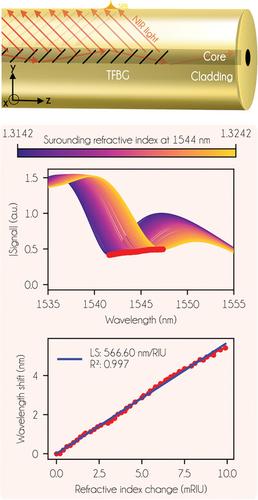当前位置:
X-MOL 学术
›
Laser Photonics Rev.
›
论文详情
Our official English website, www.x-mol.net, welcomes your
feedback! (Note: you will need to create a separate account there.)
Unraveling Plasmonic Tilted Fiber Bragg Gratings (TFBG): A Journey From “Anomalous Resonances” to Refined Refractometry
Laser & Photonics Reviews ( IF 9.8 ) Pub Date : 2024-10-29 , DOI: 10.1002/lpor.202400833 Hadrien Fasseaux, Christophe Caucheteur, Médéric Loyez
Laser & Photonics Reviews ( IF 9.8 ) Pub Date : 2024-10-29 , DOI: 10.1002/lpor.202400833 Hadrien Fasseaux, Christophe Caucheteur, Médéric Loyez

|
Plasmonic tilted fiber Bragg gratings (TFBGs) have emerged as versatile tools for refractometric analyses and biochemical sensing. Their applications have significantly blossomed these last years, from proteins and cellular bioassays to operando monitoring in batteries, to cite just a few. They are widely recognized for their cutting‐edge performance and low limits of detection, arising from their dense multimodal spectral nature featuring tens of narrowband cladding mode resonances. Their comb‐like spectrum is so rich that numerous demodulation techniques have been reported, without benchmark of their relative performance while they possess important distinctions. This review highlights developments in detangling techniques from the pioneering works based on single‐peak analysis up to the most recent approaches involving Fourier analysis, the implementation of machine learning, and cascaded spectral decomposition processes. To fairly compare the different techniques of the literature, we implemented each analysis on original experimental refractometric calibrations, revealing the assets of the most updated methods. This paper therefore reviews these demodulation techniques based on the same datasets, obtained under the same conditions. We show and discuss the results obtained from bioassays and pinpoint the importance of advanced analytical methodologies to maximize the reproducibility, reliability and performance of plasmonic‐based TFBGs biosensors.
中文翻译:

解开等离子体倾斜纤维布拉格光栅 (TFBG):从“异常共振”到精细折光率测量的旅程
等离子体倾斜光纤布拉格光栅 (TFBG) 已成为折光分析和生化传感的多功能工具。在过去的几年里,它们的应用显著蓬勃发展,从蛋白质和细胞生物测定到电池中的操作性监测,仅举几例。它们因其尖端的性能和低检测限而得到广泛认可,这源于其密集的多模态光谱性质,具有数十个窄带包层模式谐振。它们的梳状频谱非常丰富,以至于已经报道了许多解调技术,虽然它们具有重要的区别,但没有对其相对性能进行基准测试。这篇综述重点介绍了解缠技术的发展,从基于单峰分析的开创性工作到涉及傅里叶分析、机器学习实施和级联频谱分解过程的最新方法。为了公平地比较文献中的不同技术,我们对原始实验折光校准进行了每项分析,揭示了最新方法的资产。因此,本文基于相同条件下获得的相同数据集回顾了这些解调技术。我们展示和讨论了从生物测定中获得的结果,并指出了先进分析方法对于最大限度地提高基于等离子体的 TFBG 生物传感器的重现性、可靠性和性能的重要性。
更新日期:2024-10-29
中文翻译:

解开等离子体倾斜纤维布拉格光栅 (TFBG):从“异常共振”到精细折光率测量的旅程
等离子体倾斜光纤布拉格光栅 (TFBG) 已成为折光分析和生化传感的多功能工具。在过去的几年里,它们的应用显著蓬勃发展,从蛋白质和细胞生物测定到电池中的操作性监测,仅举几例。它们因其尖端的性能和低检测限而得到广泛认可,这源于其密集的多模态光谱性质,具有数十个窄带包层模式谐振。它们的梳状频谱非常丰富,以至于已经报道了许多解调技术,虽然它们具有重要的区别,但没有对其相对性能进行基准测试。这篇综述重点介绍了解缠技术的发展,从基于单峰分析的开创性工作到涉及傅里叶分析、机器学习实施和级联频谱分解过程的最新方法。为了公平地比较文献中的不同技术,我们对原始实验折光校准进行了每项分析,揭示了最新方法的资产。因此,本文基于相同条件下获得的相同数据集回顾了这些解调技术。我们展示和讨论了从生物测定中获得的结果,并指出了先进分析方法对于最大限度地提高基于等离子体的 TFBG 生物传感器的重现性、可靠性和性能的重要性。


















































 京公网安备 11010802027423号
京公网安备 11010802027423号